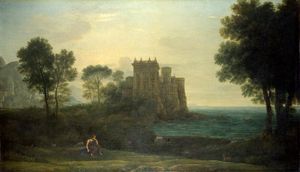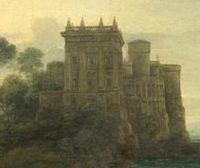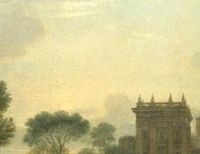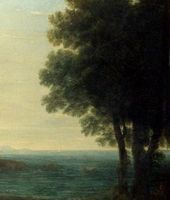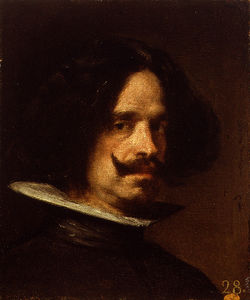The Enchanted Castle Story-Theme
- Date of Creation:
- 1664
- Alternative Names:
- Landscape with Psyche Outside the Palace of Cupid
- Height (cm):
- 87.10
- Length (cm):
- 151.30
- Medium:
- Oil
- Support:
- Canvas
- Subject:
- Landscapes
- Art Movement:
- Baroque
- Created by:
- Current Location:
- London, United Kingdom
- Displayed at:
- National Gallery London
- Owner:
- National Gallery London
- The Enchanted Castle Story-Theme Page's Content
- Story and Theme
The Enchanted Castle Story and Theme
Perhaps Claude Lorrain's most famous painting (and certainly one of his most beautiful and expressive), The Enchanted Castle takes its story from ancient Roman author Apuleius' Golden Ass (books IV-VI). A complete digression in the book narrated by an old woman, the story tells the tale of the princess Psyche, whose beauty was so overwhelming that it incited the jealousy of Venus, goddess of love and beauty.
Venus was so envious, she kept all potential suitors away from poor Psyche, much to the disappointment of her father, who was eager to marry his daughter off. The god Apollo came to Psyche's father and told him that for Psyche to find her future husband, her family would have to leave her exposed to the elements atop a rocky cliff, and so her father did just that.
Poor Psyche was left to her fate, shivering and frightened atop the desolate cliff. Malicious Venus told her son Cupid to go to Psyche and make her fall in love with some horrible creature, but when he arrived, Cupid himself fell in love with the young beauty. He had the west wind carry her away to an enchanted land. When Psyche arrived in the valley, she spent some time contemplating her unfortunate fate, then upon rising discovered an amazing, unearthly palace: the residence of Cupid. She went inside and went on to enjoy a life of luxury.
Cupid became her lover, but only came to her under the dark of night, and made her swear never to try to see him. In return, Psyche promised to stay with her mysterious lover in his castle, but only if her sisters could come, too.
This proved to be a terrible mistake, however. When Psyche's two sisters arrived and saw the wonderful gifts and riches that Cupid had bestowed upon their more beautiful sister, they were filled with jealousy, and decided to take their vengeance. They convinced Psyche that her love interest could be an evil magician, and she should try to discover his true identity.
Filled with doubts, one night Psyche lit a lamp after Cupid came to visit her, and was able to get a good look at the gorgeous god. Furious, Cupid fled the scene, but Psyche grabbed onto her lover and flew away with him, until she lost her grasp, exhausted, and fell to the ground below. Cupid flew down and remonstrated the poor girl soundly, telling her she would never see him again, then flew away.
Utterly devastated, Psyche tried to commit suicide by throwing herself in the river, but knowing Cupid's love for the girl, the river spit her right back out. Luckily, the nymph Echo and the creature Pan came to Psyche and told her to stop crying and to go and serve Cupid. After much wandering and adventures, Psyche was finally reunited with her love, and was awarded immortality.
The Commission:
Claude Lorrain painted The Enchanted Castle in 1664 for Prince Lorenzo Onofrio Colonna. Lorenzo's family was ancient Roman nobility, and this Grand Constable of the Kingdom of Naples was one of Claude's great patrons during the French Baroque artist's late period.
Some art historians suggest that The Enchanted Palace was executed on the occasion of Colonna's marriage to Marie Mancini, the niece of Cardinal Mazarin and youthful lover of King Louis XIV. The romantic story of Psyche and Cupid was a popular theme for marriages, and what's more, the tale had some striking parallels with Marie's own life.
This ill-fated dark beauty was the object of a young Louis XIV's passionate desire, but for political reasons the king was not allowed to marry her. Marie's mother had been warned by a fortune-teller that her daughter would be trouble, and on her deathbed asked that her daughter be put in a convent.
Almost following her orders, Cardinal Mazarin expeditiously organized Louis' marriage to his Spanish cousin (the famous marriage that would be the death of Spanish Baroque star Velázquez) and exiled poor Marie to an isolated chateau. In 1661 (just a few years before Claude's painting was commissioned) Marie was married to Lorenzo by proxy in Paris, and after this romantic ceremony she made the arduous trip down to Italy to join her husband.

